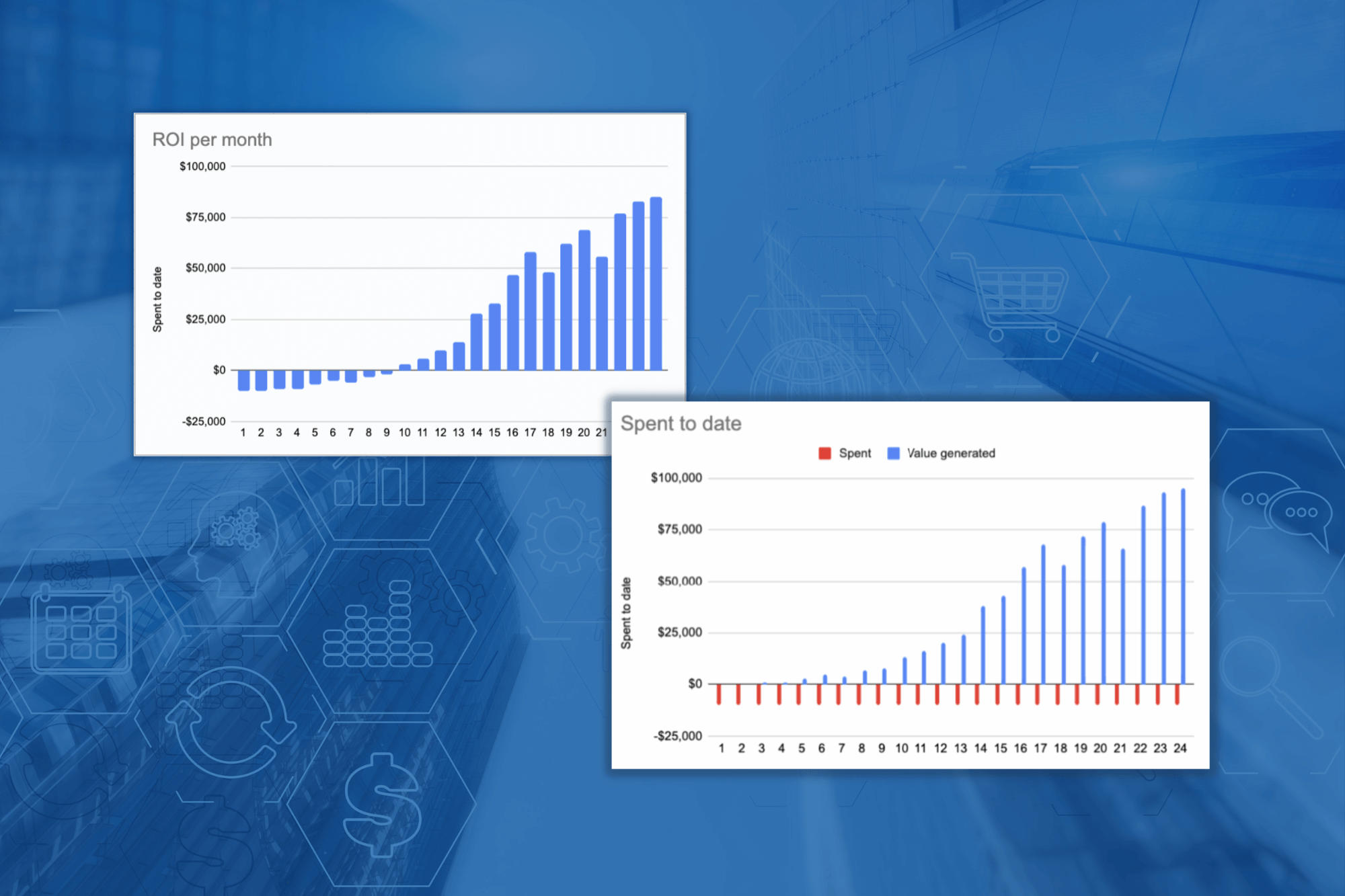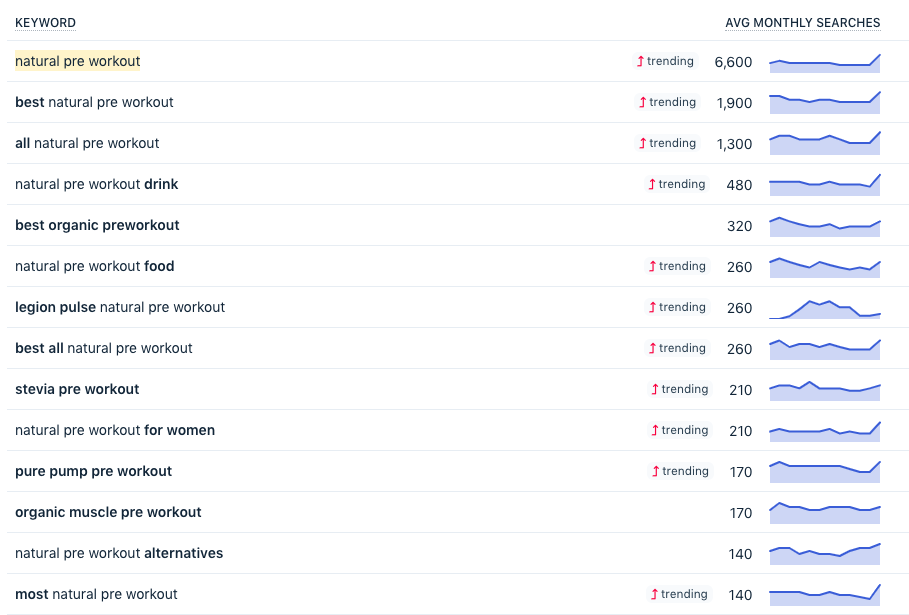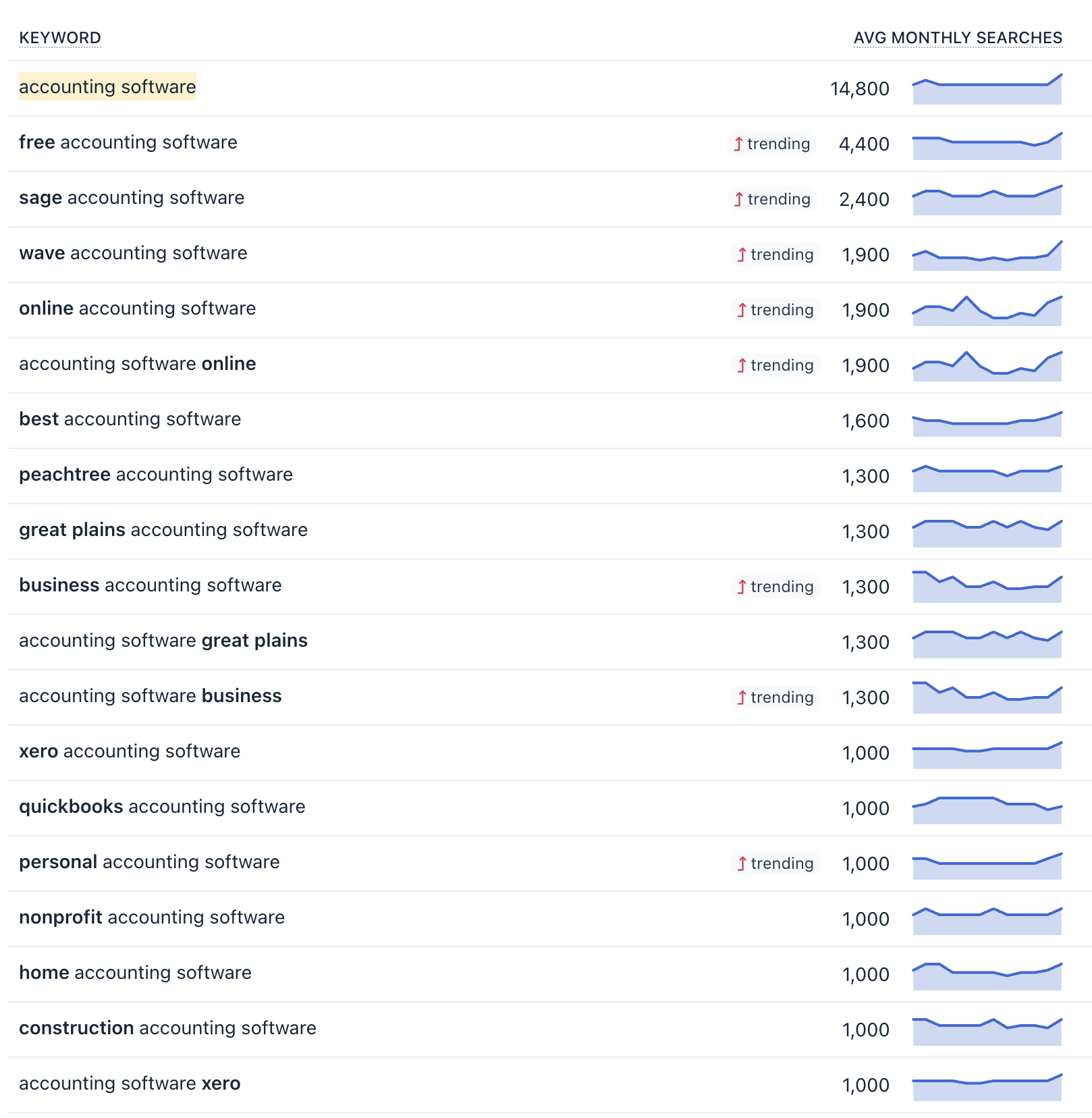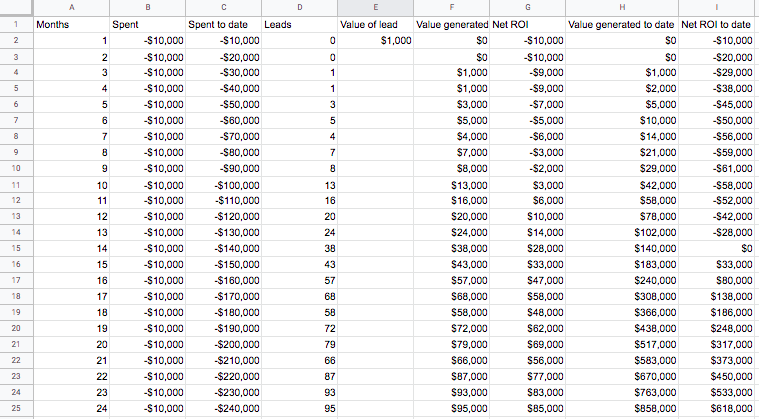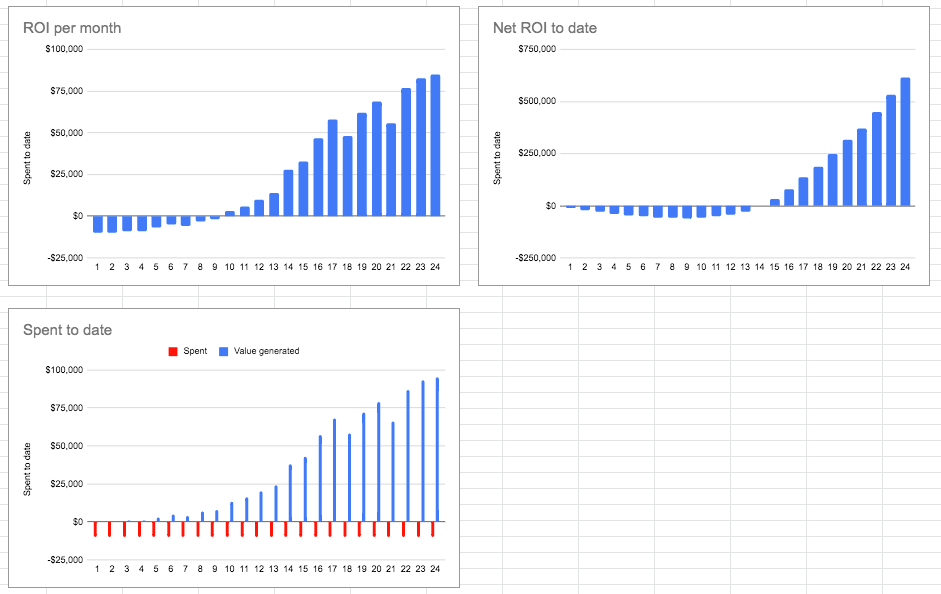Search engine optimization (SEO) is a uniquely valuable channel for many businesses because it offers two key benefits that many other marketing channels lack:
1. The results are evergreen.
When SEO is done well, once you rank for keywords that bring in traffic, leads, and customers, they continue generating this “free” organic traffic and leads for as long as those rankings are maintained. In our experience, you can maintain rankings for years if the pages you create are crafted to deeply match the search intent of the keyword.
Note: We put quotes around “free” because as we’ll discuss below, it takes effort (i.e. people and resources) to actually get and maintain those rankings, so it’s not really free. However, there is no incremental cost per visitor, so at a certain point rankings do begin generating free traffic and leads.
2. The traffic is highly targeted.
In contrast to many other digital marketing channels where audiences are only passively coming across your marketing (e.g. display advertising, social media advertising, etc.), organic search allows you to reach people who are actively searching to buy the type of product or service you sell (or solve a problem your product or service solves). As a result, we often see much higher conversion rates than many other channels if you target the right keywords.
With that said, while SEO is worth the investment for many businesses, how can you know if it’s worth it for your business?That’s what we’re going to discuss in this article.
Below, we cover:
- How costs and value of SEO change over time
- How to estimate the costs of SEO
- How to estimate your potential value of SEO
- A spreadsheet to help estimate if SEO is worth it
- Our foundational articles for businesses looking to invest in SEO
Understanding How the Costs and Value of SEO Change Over Time
At the most basic level, asking “Is SEO worth it?” means asking… Is the value I could get from SEO higher than what I’m likely to spend on it?
Doing that is, in theory, straightforward: Figure out the cost of doing SEO, estimate the revenue it could bring in, compare the two numbers. If the value is higher than the costs (positive return on investment), it’s worth it; otherwise, it’s not.
But the tricky part of this for SEO is that the value of SEO changes dramatically over time. Specifically, SEO takes time to generate traffic and leads. So the value in the early months is very low, but if brands stick with it, it can (in our direct experience across dozens of clients) generate tremendous value, multiple times higher than the monthly cost of the SEO team.
To understand if SEO is worth it for your business, you need to take a moment to understand how the costs and value of SEO change over time. This is a critical concept that we see executives and experienced marketers misunderstand all the time.
Here is this value change over time expressed as a (hypothetical) graph:
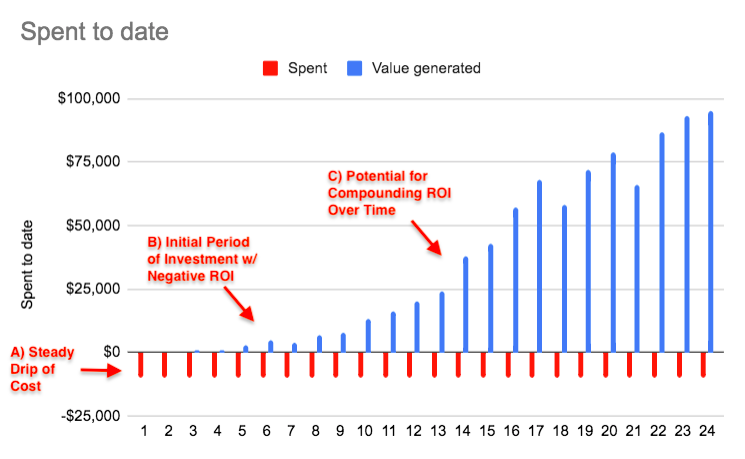
The costs of SEO are largely fixed and predictable. You’re paying someone (in-house, agency, consultant, etc.) to do keyword research, pick keywords, create pages to rank for those keywords, build links, and more. But the rub is that, unlike paid channels, there is no immediate ROI because once those pages are created and published, it takes time for Google’s algorithm to actually rank them on the first page for their intended keywords. Before pages rank for their target keywords, they can’t generate this targeted, high-converting traffic we spoke about at the beginning.
Therefore, SEO requires patience! There’s a period of initial investment where the value generated from your SEO efforts each month is less than what you’ve spent. That’s shown in the first 6-10 months of the graph above where the red line (investment) is higher than the blue lines (value generated). Then, as you begin to rank for your target keywords (typically between months 5-10), website traffic and conversions begin to tick up subtly. As your rankings compound (often at the one year mark and beyond), the traffic and leads from your efforts begin to produce more value than your monthly spend. In our experience, it doesn’t take long from there to recoup the initial period of investment.
At that point, your business can make money from the rankings you’ve acquired (which have already been paid for), while continuing to spend that same incremental monthly cost to produce more content and get more rankings (or, optionally, stopping further SEO investment and letting the rankings you acquired continue producing results while you cut off spend entirely). ROI can grow at a relatively linear rate from that point, and generally levels off as you exhaust high-buying-intent keyword opportunities in your space.
This is the thing to understand about how the value of SEO can work in an ideal context over the long-term, with the following two assumptions:
- There’s good keyword search volume and conversion potential in your space (i.e. the potential SEO value for your business is higher than the likely costs)
- Your SEO strategy is focused on targeting buying intent keywords that drive actual revenue for your business (not brand awareness, traffic-chasing, low intent keywords)
We’ve written at length about the latter point which is essential and we’ll link to those articles below. The rest of this piece will focus on helping you decide if the first assumption — that the potential value of SEO is higher than the costs — is true for your business.
How to Estimate the Costs of SEO
The cost of SEO is mostly based on the cost of the people you pay to do the work, whether that’s an agency, a group of freelancers and/or consultants, or an in-house SEO manager or team.
The key thing to understand about SEO costs is that — as per the red lines in the graph above — they usually stay relatively fixed. Yes, you can decide to scale content creation efforts up or down, produce more or less content in a given month, pay for more or less backlinks, but by and large, most companies we work with reach a steady state or rhythm of content production and link building, so their monthly SEO costs stay fixed.
In terms of how much you should expect to spend, it’s not going to cost you $50k per month, nor is it going to cost you $200 per month. Depending on what the makeup of your team looks like, you should expect to spend somewhere in the mid to high thousands. The most popular plan for our SEO agency, for example, is $10,000 per month.
When it comes to estimating your costs, Google or ask around to price out options for SEO services, freelance SEO experts, or in-house SEOs. If you want current employees to do SEO work for you, calculate what percentage of their time they’d spend on SEO and multiply that by their salaries. But the bottom line is not to worry about this being exactly right, just aim for a number that’s close enough and move on to estimating your potential value from SEO.
As we’ll discuss below, the whole point of SEO is that once you cross breakeven, it has a positive impact that should far outweigh your initial costs to get rankings. So even if you’re off by thousands of dollars a month, if SEO is worth it for you, the value and potential customers it can generate shouldn’t be slightly higher than your cost, it should be far higher. If it’s a close call, it’s likely SEO isn’t worth integrating into your marketing efforts.
How to Think About and Estimate the Value of SEO for Your Business
Estimating the value of SEO for your business is not easy, but it’s possible to map out some ballpark numbers that can help you get a baseline understanding of whether or not SEO could be worth investing in. Approach this part as a go/no-go or pass/fail decision.
Don’t try to get overly precise with exact ROI estimates — as we explain below, there are many reasons why it’s basically impossible to estimate exact SEO ROI.
We’re going to look at this in terms of two factors you should consider:
- Traffic Potential: Are enough searchers looking for the product or service you sell? If so, what’s the search volume and potential traffic you could get from SEO?
- Conversion Potential: How many conversions (leads or sales) could you get from that additional organic traffic to your site?
Ultimately, you’re looking to estimate whether you can get enough organic traffic to produce conversions (based on an average conversion rate) that generate more revenue than what you spend on SEO.
Let’s take a closer look at each factor.
1. How Much Potential Traffic Can SEO Help Generate?
The first key thing to investigate is whether people are searching for your product or service in Google and other search engines. If no one is searching for what you sell, then SEO likely will not be worth an investment. This is the #1 (and probably only) reason you should rule out SEO as a channel.
If people are searching for what you sell, then you need to get a sense of how many people are searching every month — referred to as search volume. Search volume is the number of searches per month for a given keyword. And you can find this data in any keyword research tool such as Ahrefs, Semrush, Clearscope, or many others.
A good place to start is figuring out how many monthly searches and keyword variations there are for the terms that describe your product or service. Just type your business category into a keyword research tool and see what comes up.
For example, if you sell a natural pre-workout drink mix, see what keywords and associated search volumes come up for that. Here’s what we see in Clearscope for “natural pre workout”:
At a glance, we can see there are thousands of monthly searches for keywords with really high buying intent in this category, and many different keyword variations. So, if this is what you sold, this would be an indicator that SEO is likely worth investing in, given that the value of traffic to your site is high enough (discussed next).
Alternatively, if you sell a super niche, innovative product that your market generally doesn’t know about yet, you might find that no one is searching for what you sell — in which case, SEO may not be the best channel for you.
For example, one of our current clients previously ran a business where they developed a product for validating the authenticity of B2B testimonials and case studies. If we type in “B2B testimonial authentication tool”, we find that (unsurprisingly) there’s no registered search volume for this keyword:
The same goes when we try searching for “validate case studies” or “validate testimonials.” Indeed, they told us that they used outbound sales almost exclusively and their sales people had to explain both the concept and the value of their product to customers, confirming the idea that no one was looking for this.
Could it be possible for them to create demand and define a category with enough content marketing elbow grease? Maybe. But they’d need to be really willing to play the long game and most companies don’t have the budget or wherewithal for this.
Ideally, you want to see decent search volume for your business category. But it’s also important to understand that this works on a sliding scale with the size of your target audience and the price of your product. If you sell a high priced B2B SaaS where customers spend thousands of dollars with you every month and stay with you on average for a year and a half, there’s obviously a lot less people searching for this than a consumer product like a natural pre workout drink mix. But that’s okay because you may only need 5 or 10 customers per month to break even on your monthly spend.
Ballpark Estimates of Number of Keywords and Search Volume
That said, in general, when taking on new B2B clients, we typically do some quick keyword research to see if we can easily find 20 – 40 keywords with decent buying intent. We don’t need to find the exact keywords immediately, but we see if it’s easy to find dozens of keywords. (Our best, longest running clients have hundreds of keywords with some buying intent.)
If it’s a struggle to find ~20 keywords that you think have buying intent, then you may be in a niche where SEO isn’t the best channel. It doesn’t mean SEO is totally not worth it, but you should think of it as a short term investment to rank for however many high-buying-intent keywords you do have, and then move on.
Alternatively, if you can easily put a couple of obvious keywords into any SEO keyword research tool and, within minutes, find dozens of keywords that simple logic would tell you are high-buying-intent, you’re likely okay. Most products and services we’ve run into are in this category. It’s actually quite rare to run into a profitable business in a niche so innovative that no one is searching for it. If it has a market, it likely has search volume.
For example, if you sold accounting software, this is what you’d see in any keyword research tool:
There are dozens upon dozens of keyword variants containing just “accounting software”. Other ideas would bring up even more. This is obviously a highly-searched-for example — your product or service may very well not have this level of search volume — but you get the idea.
Finally, don’t forget to also check for slightly higher in the funnel keywords that still have good buying intent. The above examples only show screenshots of us searching for the most obvious “category name” type of searches: “natural pre-workout”, “accounting software”. But as per Pain Point SEO, there are usually tons of use cases, how to’s, or other question-based queries that also have good buying intent. For example, for pre-workout drinks, you could try topics like “are pre-workout drinks effective” or “tips for getting a good workout”. In the accounting software example, you could try “how to generate a balance sheet” or “how to do small business accounting”.
Next, What Search Volumes Are Good Enough?
This is harder to give ballparks for because they depend so much on the industry. But in general, for B2B companies, we are comfortable if we see keywords with 20+ monthly searches and at least a handful with 100+ monthly searches. Yes, this seems low, but in our experience, if you rank for a keyword with a reported search volume of 50/month, you typically get at least that many organic pageviews from that page every month (full article) or often much more (see below).
For B2C or lower priced ecommerce products, where you’ll need more traffic and conversions to recoup SEO costs, there should be many keywords with 3 and even 4 figure monthly search volume. For most B2C businesses, this typically isn’t a problem (consumer search terms just have a lot more volume than business terms).
Now, importantly, you shouldn’t assume that if you rank for a keyword with a certain monthly search volume, that you’ll only get a small fraction of that volume. For example, don’t do this typical granular calculation: “Ok, 1000 searches a month, and if we rank #1 and get 30% of clicks, then that’s 300 pageviews…”. You will severely underestimate traffic this way.
Here is an example using one of our own articles to show how the actual traffic we are getting is 5X higher than what this kind of bottoms up calculation would estimate:
Instead, a good rule of thumb is if you rank highly for keywords with hundreds of searches per month, you’re likely to get hundreds of pageviews a month from each of those keywords (or, as per the example in that Twitter thread, potentially a lot more). If you rank for keywords with thousands of searches a month, you’re likely to get thousands of pageviews per month from each of those keywords.
So, start by getting a sense of search volume for the keywords that describe your business, assume that with top rankings for those keywords you could get somewhere in the vicinity of that amount of traffic (or more), and then move onto the next step of determining the potential conversion value of that traffic.
2. How Many Potential Conversions Could You Get From That Targeted Organic Traffic?
A simple way to estimate the total number of potential conversions from that traffic is to multiply whatever estimated traffic number you came up with by an average conversion rate.
For example, let’s say you’re a B2B business that’s found 40 high-buying-intent keywords with an average search volume of 40 searches per month. And per what we discussed above, you determine you could conservatively drive 1,600 organic sessions per month if you ranked in top positions for those keywords.
To estimate the potential conversions from that traffic, you could simply multiply that by an average conversion rate of 1%.
Note: The conversion rates we see from the content we produce for our clients range from 0.5% to 5% for a single article and average about 0.5% to 2% across dozens of articles. However, for the purpose of making a conservative estimate, assume that an average conversion rate of 1% is safe for high-buying-intent keywords.
So, continuing with the example of 1,600 monthly visitors to your high-intent pages, you could conservatively estimate receiving 16 leads per month. With a $1,000 value of a lead (a simple round number — you can calculate this by taking the first year annual value of a paying customer and multiplying by your lead-to-close rate), 16 leads would produce $16,000 of value per month.
Next, you need to put this into context alongside your monthly spend. So, taking our agency’s monthly cost of $10,000, for example, that would be $6,000 or 60% ROI per month. Therefore, this napkin math would indicate that the potential conversions you could get would make an investment in SEO worth it to you.
Caveat: Don’t Try to Get Too Precise with These Estimates
Note that these estimates have a lot of assumptions built in (as estimates like this tend to do). So be careful not to get too precise with it.
The reality is, you don’t actually know where you’ll rank or how long it will take to get there. You also don’t know how much traffic will actually be generated with that ranking (as we said, it’s almost always way more than what SEO tools estimate). Finally, you don’t know the actual conversion rate you’ll get after you rank (which is also heavily dependent on how well you sell your product in the articles).
So instead of over-calculating what your likely revenue from SEO is, we suggest you just think of this as “go/no-go” — that is, is SEO likely worth it enough to try or not. Or, if you want to get more precise, simply test SEO as a channel with a handful of articles, say 5 or 10, and you’ll get a much better feel of what the actual numbers are compared to your estimates.
Also note that conversion rate, in particular, will vary significantly by article and keyword. So all the more reason why we suggest you start with the highest buying intent keywords that convert the highest. You might as well grab that low hanging fruit first and see what the top end potential of SEO can be.
Other Key Considerations
1. How Many Months Can You Afford to Invest in SEO Before Hitting Breakeven on Your Monthly Spend?
In our experience, it takes between 6-12 months to amass enough top search rankings for our clients to hit the conversion volume required to breakeven on their monthly spend.
Due to the time it takes for pages to rank for their intended keywords once they’re published, you need to ask yourself: do you have the capacity to wait that long? Can you afford that monthly cost for, say, 10 months before you begin getting positive ROI on your monthly spend?
If not, SEO might not be a reasonable channel for you to invest in right now, or you may need to find cheaper ways to test it. On the other hand, if you can afford that, there can be huge upside and ROI that comes later, as we discussed above.
2. Benchmarking Long-Term Conversion Potential
It’s also worth trying to benchmark what SEO success could look like over the long-term. You can think about this in a couple of ways.
First, if you’ve been running your business for a while, you can ask: how many leads per month are you getting in total? And how many are currently coming from organic rankings?
If you’re getting 100 leads per month, for example, and barely any are coming in from organic search — or, you’re getting leads from a couple of high-intent keywords and you see dozens more which you aren’t ranking for that could also bring in leads — it’s pretty reasonable to estimate you could get another 100+ leads per month from SEO.
Alternatively, if your homepage and product landing pages are already ranking for the main high-intent keywords in your space, but there’s some more long tail buying intent keywords, plus a decent number of mid or top of funnel keywords you could go after, you might estimate that that you could increase your total number of leads from SEO by something like 50% by going after those keywords with your blog.
Again, this is all just ballpark estimates, but benchmarking this long-term potential based on guidelines of what you’re already generating is a practical way to get a decent idea of the potential value SEO could drive for you.
3. Scaling Content to Drive Additional Conversions From Higher Volume, Lower Intent Keywords (AKA Top of Funnel)
In the examples we’ve discussed throughout this post, we’ve focused on buying-intent keywords and search volumes. However, for most businesses, there are many lower-intent search queries that their target audiences are searching that can also drive conversions — just at a much lower conversion rate.
Once you’ve tackled your high-buying-intent keywords, you can move up the funnel and take into account potential keywords that have much higher search volumes. This increases the volume of conversions beyond what you’ve estimated in the conservative calculations above.
A Spreadsheet You Can Use to Help Estimate If SEO Is Worth It for You
To help you calculate and visualize ballpark estimates of the value of SEO for your business, we’ve created a spreadsheet that you can make a copy of and modify with your own data.
It includes the following:
- Inputs: Columns to input your value of a lead, estimated monthly spend, and estimated number of leads you could generate each month as you progress doing SEO.
- Outputs: Columns that calculate your spend to date, value generated from SEO, net ROI, value generated to date, and net ROI to date.
- Charts: Graphs that automatically reflect the inputs you enter and allow you to visualize your ROI per month over time, net ROI to date over time, and spend versus value generated to date.
The numbers in the spreadsheet are hypothetical placeholders to demonstrate the concept of how ROI works in SEO.
In addition, we’ve included a calculator for determining the amount of traffic you’d need at different conversion rates to get your desired number of leads.
Click here to download the spreadsheet and make your own copy.
Further Reading: Articles for Businesses Looking to Invest in SEO
SEO Strategy
- Pain-Point SEO: How to produce SEO content that drives conversions
Learn about our agency’s foundational SEO strategy and how we approach it differently than other agencies.
- SEO keyword strategy: How to prioritize based on buying intent to drive more conversions
Most articles on SEO keyword strategy barely discuss prioritizing based on buying intent. This post explains how to create an SEO keyword strategy that’s focused on finding and prioritizing keywords that will drive measurable ROI for your business.
Content Creation
- SEO content writing: A 5-step process you can follow
This post explains how to analyze search engine results pages (SERPs) for a target keyword, and create high-quality, tailored pages to rank highly for that keyword.
Measuring SEO Results
- Using Google Analytics goals to measure lead generation from content
This post outlines an extremely simple way to begin attributing leads generated from your website — using a thank you page combined with Google Analytics goals.
- Content marketing attribution: How to measure content performance
This article outlines a more advanced (and more accurate) way of measuring lead generation or conversion rates from content.
Case Studies of Our Work with Clients
Here are 6 client case studies you can read to see how we’ve executed our SEO strategy for real businesses:
How to Work with Us or Learn More
- Our Agency: If you want to hire us to execute a content-focused SEO strategy, you can learn more about working with us here.
- Join Our Team: If you’re a content marketer or writer and would love to do content marketing in this way, we’d love to have you apply to join our team.
- Our Content Marketing Course: Individuals looking to learn our agency’s content strategy and become better marketers, consultants, or business owners can join our private course and community, taught via case studies, and presented in both written and video content formats. We include several details and examples not found on this blog. Our course is also built into a community, so people ask questions, start discussions, and share their work in the lesson pages themselves, and we, along with other members, give feedback. Learn more here.

